|
|
|
Sort Order |
|
|
|
Items / Page
|
|
|
|
|
|
|
| Srl | Item |
| 1 |
ID:
129104
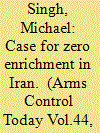

|
|
|
|
|
| Publication |
2014.
|
| Summary/Abstract |
In the debate over sanctions on Iran-their role in bringing Tehran to the negotiating table and their proper place in U.S. diplomatic strategy in the future-scant attention has been paid to a major shift in the negotiating position of the P5+1, the group of six countries (China, France, Germany, Russia, the United Kingdom, and the United States) that is negotiating with Tehran over the Iranian nuclear program. No longer is the P5+1 demanding that Iran halt uranium enrichment. Indeed, in the November 24 first-step nuclear accord, the Joint Plan of Action,[1] the P5+1 all but concedes that Iran will be permitted to enrich in perpetuity. In separate comments that have quickly become conventional wisdom among Iran analysts, U.S. negotiators now characterize their previous position that Iran should halt enrichment as "maximalist."[2] Although undoubtedly expedient, this shift away from a zero-enrichment negotiating position is misguided and unnecessary.[3] The U.S. shift away from zero enrichment to limited enrichment represents a significant diplomatic victory for Iran. For the last decade, the position of the EU-3 (France, Germany, and the UK) and then the P5+1 had been that Iran must "suspend all enrichment-related and reprocessing activities, including research and development." This position was enshrined as an Iranian obligation in a series of UN Security Council resolutions.[4] Iran, however, asserted a "right to enrich" and refused to halt enrichment after resuming it when nuclear talks with the European Union broke down in 2005. This difference formed the core of the confrontation that subsequently developed between Iran and the allies.
|
|
|
|
|
|
|
|
|
|
|
|
|
|
|
|
| 2 |
ID:
129134
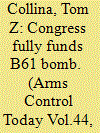

|
|
|
|
|
| Publication |
2014.
|
| Summary/Abstract |
Striking a compromise on a controversial issue, Congress in January passed legislation to provide $537 million, the full amount the Obama administration had requested, for the program to rebuild the B61 nuclear gravity bomb and require the administration to submit detailed reports on alternatives to this plan. Congress also mandated the eventual retirement of a different gravity bomb, the B83, once the B61 is ready for service. These items were part of an omnibus appropriations bill signed by President Barack Obama on Jan. 17. The new law is a $1.1 trillion conglomeration of 12 appropriations bills that had to be passed to keep the government open for the remainder of the fiscal year, which ends Sept. 30. The legislation includes $7.8 billion for nuclear weapons activities conducted by the Energy Department's semiautonomous National Nuclear Security Administration (NNSA). One of the key nuclear policy questions left unresolved last year was how much money the NNSA would be allowed to spend to extend the service life of about 400 B61 gravity bombs. About half of the B61s are stored in European NATO countries for use on tactical, or short-range, aircraft; the rest are stored in the United States for use on strategic, or long-range, bombers.
|
|
|
|
|
|
|
|
|
|
|
|
|
|
|
|
| 3 |
ID:
129103
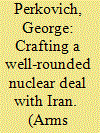

|
|
|
|
|
| Publication |
2014.
|
| Summary/Abstract |
A final nuclear deal with Iran should meet the underlying objective of the relevant UN Security Council resolutions since 2006: "the establishment of international confidence in the exclusively peaceful nature of Iran's nuclear programme."A final agreement could be codified and endorsed through a new resolution, which need not include all of the specific instrumental elements of past resolutions-for example, suspension of all uranium enrichment-if the council determines that the overall objective has been met. As the resolutions acknowledge, to be durable, such an agreement also must satisfy Iran's interest in having a purely peaceful nuclear program free from sanctions. The devilish challenge will be in the details. History will inform each party's requirements. The six-country group that has been negotiating with Iran, the so-called P5+1 (China, France, Germany, Russia, the United Kingdom, and the United States), will remember that Iran secretly had, at least until 2003, what appeared to be a dedicated, multifaceted program to acquire capabilities to produce nuclear weapons. Iran still has not cooperated fully with the International Atomic Energy Agency (IAEA) to clarify these activities and continues to expand sensitive fuel-cycle capabilities beyond any plausible civilian requirement. Iranian leaders, for their part, remember numerous episodes that reflect a U.S. determination to hasten an end to their regime.
|
|
|
|
|
|
|
|
|
|
|
|
|
|
|
|
| 4 |
ID:
129109
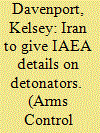

|
|
|
|
|
| Publication |
2014.
|
| Summary/Abstract |
Iran will provide the International Atomic Energy Agency (IAEA) with information about its past development of a detonator that could be used to as a trigger in nuclear weapons, according to an agreement reached by the two sides last month. In a Feb. 9 joint statement, Iran and the IAEA described the two days of talks in Tehran as "constructive" and announced seven actions for Iran to take by May 15 to further the agency's investigations into its unresolved concerns about Iran's current nuclear program and past actions. One of the actions requires Tehran to provide the IAEA with information on exploding bridge wire detonators, which can be used to trigger nuclear weapons. They can also be used in civilian applications, including drilling for oil and gas, and for conventional military explosives.
|
|
|
|
|
|
|
|
|
|
|
|
|
|
|
|
| 5 |
ID:
129108
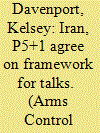

|
|
|
|
|
| Publication |
2014.
|
| Summary/Abstract |
After three days of talks in Vienna, Iran and six world powers agreed last month on a framework and timetable to guide the first four months of negotiations on a comprehensive deal on Iran's nuclear program. EU foreign policy chief Catherine Ashton, who leads the negotiating team for the six-country group known as the P5+1 (China, France, Germany, Russia, the United Kingdom, and the United States), said in a Feb. 20 statement that the parties had "identified all of the issues" to be addressed in the comprehensive agreement. An official who was briefed on the talks told Arms Control Today in a Feb. 20 e-mail that this is not a "written agenda" but an "understanding of the issues that must be covered." The official, who is from a P5+1 country, said that most of the discussions were on process but that "some substance was covered." The Feb. 18-20 meetings marked the resumption of political-level negotiations between Iran and the P5+1, following a Nov. 24 agreement on a plan of action, which laid out initial steps for each side to take and the broad parameters to guide negotiations on the comprehensive deal. (See ACT, December 2013.)
|
|
|
|
|
|
|
|
|
|
|
|
|
|
|
|
| 6 |
ID:
129119
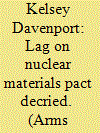

|
|
|
|
|
| Publication |
2014.
|
| Summary/Abstract |
The failure of several key states to ratify a nuclear security treaty ahead of this month's nuclear security summit is a disappointment, but an Indonesian initiative may increase the pace of ratifications, an official familiar with the preparations for the meeting said. The two previous nuclear security summits, in Washington in 2010 and Seoul in 2012, have emphasized the importance of the entry into force of a 2005 amendment to the Convention on the Physical Protection of Nuclear Material (CPPNM). The March 24-25 summit in The Hague is also likely to encourage ratification of this treaty. The original treaty, which entered into force in 1987, sets security standards for nuclear material in transit. Its 2005 amendment would expand the scope of the physical protection measures to cover material in storage. An additional 26 ratifications are necessary to reach the 98 necessary for bringing the amendment into force. Although the 2012 Seoul summit communiqué urged states "in a position to do so to accelerate their domestic approval" of the amendment in order to achieve entry into force by 2014, 17 of the 53 summit participants have yet to ratify it
|
|
|
|
|
|
|
|
|
|
|
|
|
|
|
|
| 7 |
ID:
129126
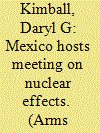

|
|
|
|
|
| Publication |
2014.
|
| Summary/Abstract |
For the second time in two years, diplomats and civil society representatives gathered last month for a two-day conference on the medical and societal impacts of nuclear weapons use, with many governments calling for "new international standards and norms, through a legally binding instrument," according to the chair's summary of the meeting. The agenda of the Feb. 13-14 conference in Nayarit, Mexico, included several presentations from survivors of the Hiroshima and Nagasaki bombings and from experts on the effects of and responses to single nuclear detonations and large-scale nuclear attacks. "It is a fact that no State or international organization has the capacity to address or provide the short- and long-term humanitarian assistance and protection needed in case of a nuclear weapon explosion," concluded Juan Gómez Robledo, conference chair and undersecretary for multilateral affairs and human rights in the Mexican Foreign Ministry. The Nayarit gathering brought together 146 government representatives-more than the 127 that met in Oslo, Norway, in March 2013 for the first such conference.
|
|
|
|
|
|
|
|
|
|
|
|
|
|
|
|
| 8 |
ID:
129132
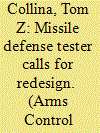

|
|
|
|
|
| Publication |
2014.
|
| Summary/Abstract |
The Defense Department's chief weapons tester called in January for the redesign of a key component of the U.S. system intended to intercept long-range missiles launched from North Korea or Iran, raising questions about the department's plans to expand the current system. J. Michael Gilmore, the Pentagon's director of operational test and evaluation, wrote in his annual report, released Jan. 29, that recent test failures of the U.S. ground-based interceptor (GBI) system raise concerns about the system's reliability and suggested that the missile's exoatmospheric kill vehicle (EKV) be redesigned to assure it is "robust against failure." Echoing Gilmore's view, Frank Kendall, undersecretary of defense for acquisition, technology and logistics, told a Feb. 25 conference in Washington, "We've got to get to more reliable [missile defense] systems." Merely "patching the things we've got is probably not going to be adequate. So we're going to have to go beyond that," he said. The EKV plays a central role in the missile defense mission. It is lifted into space by a booster rocket and then uses its onboard sensors to locate an incoming enemy warhead and destroy it on impact. U.S. officials have compared the task to hitting a bullet with another bullet.
|
|
|
|
|
|
|
|
|
|
|
|
|
|
|
|
| 9 |
ID:
129133
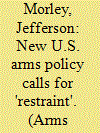

|
|
|
|
|
| Publication |
2014.
|
| Summary/Abstract |
The Obama administration in January announced a new policy on conventional arms transfers that emphasizes the need for restraint in considering transfers that might endanger regional security or human rights. President Barack Obama declared in a Jan. 15 directive that the new policy "supports transfers that meet legitimate security requirements of our allies and partners in support of our national security and foreign policy interests" and "promotes restraint" in those "that may be destabilizing or dangerous to international peace and security." The policy, which replaces a 1995 directive issued by President Bill Clinton, follows the administration's announcement last October that it was loosening rules on the sale of U.S.-made weapons overseas. The reforms announced last fall are part of an effort that the administration says will tighten controls on the sale of the most dangerous arms while enhancing commerce in defense material and services that are not threatening.
|
|
|
|
|
|
|
|
|
|
|
|
|
|
|
|
| 10 |
ID:
129106


|
|
|
|
|
| Publication |
2014.
|
| Summary/Abstract |
This year marks the 60th anniversary of the Castle Bravo nuclear detonation in the Marshall Islands. The U.S. military conducted 67 nuclear tests in the Pacific Proving Grounds from 1946 to 1958. The Castle Bravo test, conducted on March 1, 1954, at Bikini Atoll, was 1,000 times the force of the Hiroshima bomb. The explosion sent irradiated coral dust throughout the atolls. Neighboring atoll populations, who were neither informed of the tests nor relocated prior to the detonation, today continue to experience health issues, cultural upheaval, and physical dislocation due to the environmental degradation produced by the test and the effects of climate change. The Bravo detonation remains the largest nuclear test ever conducted by the United States.[1] Although the United States tested an additional 55 nuclear weapons in the Marshall Islands, Castle Bravo is the most notorious due to its impact, primarily on the people of the Marshall Islands.
|
|
|
|
|
|
|
|
|
|
|
|
|
|
|
|
| 11 |
ID:
129107
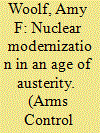

|
|
|
|
|
| Publication |
2014.
|
| Summary/Abstract |
When Secretary of Defense Chuck Hagel spoke about U.S. nuclear forces at F.E. Warren Air Force Base in early January, he emphasized two key points. First, he declared that the United States was "going to invest in the modernization we need to invest in to keep that deterrent stronger than it's ever been." He then added that "we're going to continue to require every element of our nuclear deterrent in the triad."[1] His audience at the Wyoming base might have heard a welcome, if unexceptional, commitment to the future of the U.S. nuclear deterrent, but there could have been more to the secretary's comments. In this period of fiscal constraints and declining defense budgets, many in in the wider policy community are voicing doubts about the ability of the United not only to maintain all three legs of the nuclear triad, but also to replace each leg with new missiles, bombers, and submarines. Although the current debate over the future composition of the U.S. nuclear arsenal often is framed in fiscal terms, it is more about the future need for and role of nuclear weapons than it is about how much money the U.S. government is going to spend on them. Critics of the current plans to modernize the U.S. nuclear force structure argue that the investments are excessive because nuclear weapons are less relevant to U.S. national security in the 21st century than they were in the past. Supporters argue that this investment is necessary because nuclear weapons continue to play a critical role in U.S. national security. Regardless, if defense budgets continue to decline in the coming decades, the country may face difficult and possibly illogical trade-offs as it pays for the rising cost of nuclear modernization. The United States deploys strategic nuclear warheads on three types of delivery vehicles: long-range, land-based intercontinental ballistic missiles (ICBMs), long-range submarine-launched ballistic missiles (SLBMs), and long-range heavy bombers based in the United States. Each of the delivery systems in the U.S. nuclear force is aging, and all could reach the end of their service lives in the next 30 years. The warheads that these systems would deliver also are more than 25 years old and contain aging components that may raise questions about their reliability in the future
|
|
|
|
|
|
|
|
|
|
|
|
|
|
|
|
| 12 |
ID:
129105
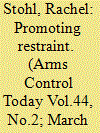

|
|
|
|
|
| Publication |
2014.
|
| Summary/Abstract |
On January 15, 2014, the United States released a document describing its new policy governing transfers of conventional weapons. The policy revision was long overdue, as the new publicly released document, Presidential Policy Directive 27 (PPD-27),[1] replaced a classified directive that came out in 1995.[2] The world has changed dramatically since the end of the Cold War. Until the release of the new policy document, however, the United States had been using policy guidance rooted in the geopolitical challenges created by the fall of the Soviet Union in making its arms transfer decisions and in outlining policy priorities and approaches to the global arms trade. According to a White House summary, a multi-year interval review of U.S. arms export policy "concluded that the 1995 conventional arms transfer policy was effective but needed to be updated to address 21st century national security and foreign policy objectives."[3] Thus, the new U.S. policy more accurately reflects the reality of U.S. arms transfers today. The Obama administration began its review when it came into office, but U.S. officials have said the impetus to finish the review came from events during the Arab Spring, when canisters of tear gas emblazoned with "Made in the USA" dominated pictures of the uprisings in Cairo's Tahrir Square. Questions surrounding U.S. arms sales to Egypt and other Arab countries led to increased scrutiny over the process of determining whether to transfer conventional arms and whether arms sales in fact led to U.S. influence over the recipient.
|
|
|
|
|
|
|
|
|
|
|
|
|
|
|
|
| 13 |
ID:
129135
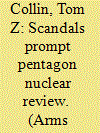

|
|
|
|
|
| Publication |
2014.
|
| Summary/Abstract |
In the wake of recent reports that some Air Force nuclear missile operators have been cheating on performance tests and failing to follow safety rules, the Defense Department announced Jan. 23 that it is launching a review of all U.S. nuclear forces, to be completed in three months. Defense Secretary Chuck Hagel said at a Jan. 24 press conference that he is "deeply concerned" about "the overall health and the professionalism and discipline of our strategic forces." At the Jan. 23 announcement event, Pentagon spokesman John Kirby said that the review would look not just at the Air Force's intercontinental ballistic missile (ICBM) force, the main source of the problems, but at the "whole nuclear force," including the Air Force's long-range bombers and the Navy's strategic submarines.
|
|
|
|
|
|
|
|
|
|
|
|
|
|
|
|
| 14 |
ID:
129110
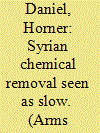

|
|
|
|
|
| Publication |
2014.
|
| Summary/Abstract |
Amid increasing frustration over the pace of Syria's removal of chemical weapons materials for overseas destruction, Syrian authorities are in talks with key countries and experts from the Organisation for the Prohibition of Chemical Weapons (OPCW) and the United Nations on a revised timetable for the removal effort, according to media reports and spokesmen for some of the parties in the negotiations. Syria has proposed a timetable that would take until about the end of May, but the U.S. government "believes that the Syrians are more than capable of moving these chemicals to Latakia on a shorter timetable," a State Department spokesman said in a Feb. 28 e-mail to Arms Control Today. Latakia is the port city in northwestern Syria where the Syrian government is collecting the chemicals from across the country before sending them overseas for destruction.
|
|
|
|
|
|
|
|
|
|
|
|
|
|
|
|
| 15 |
ID:
129131
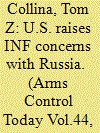

|
|
|
|
|
| Publication |
2014.
|
| Summary/Abstract |
The U.S. State Department confirmed in January that Russia may have breached a landmark arms control agreement by testing a new cruise missile, but has not concluded that Russia violated the accord.
Confirming the details of a Jan. 29 report in The New York Times, State Department spokeswoman Jen Psaki said at a Jan. 30 press briefing that the United States has raised the "possibility of…a violation" with Russia and U.S. NATO allies. The specific U.S. allegation is that Moscow flight-tested a new medium-range, land-based cruise missile. Such a test would run afoul of the 1987 Intermediate-Range Nuclear Forces (INF) Treaty, which permanently bans ground-launched ballistic or cruise missiles capable of traveling 500 to 5,500 kilometers. Rose Gottemoeller, acting undersecretary of state for arms control and international security, has discussed the issue with her Russian and NATO counterparts, Psaki said, adding that "there's still an ongoing review, an interagency review, determining if there was a violation." Psaki indicated that the administration does not view the INF Treaty as being in serious jeopardy.
|
|
|
|
|
|
|
|
|
|
|
|
|
|
|
|
|
|
|
|
|